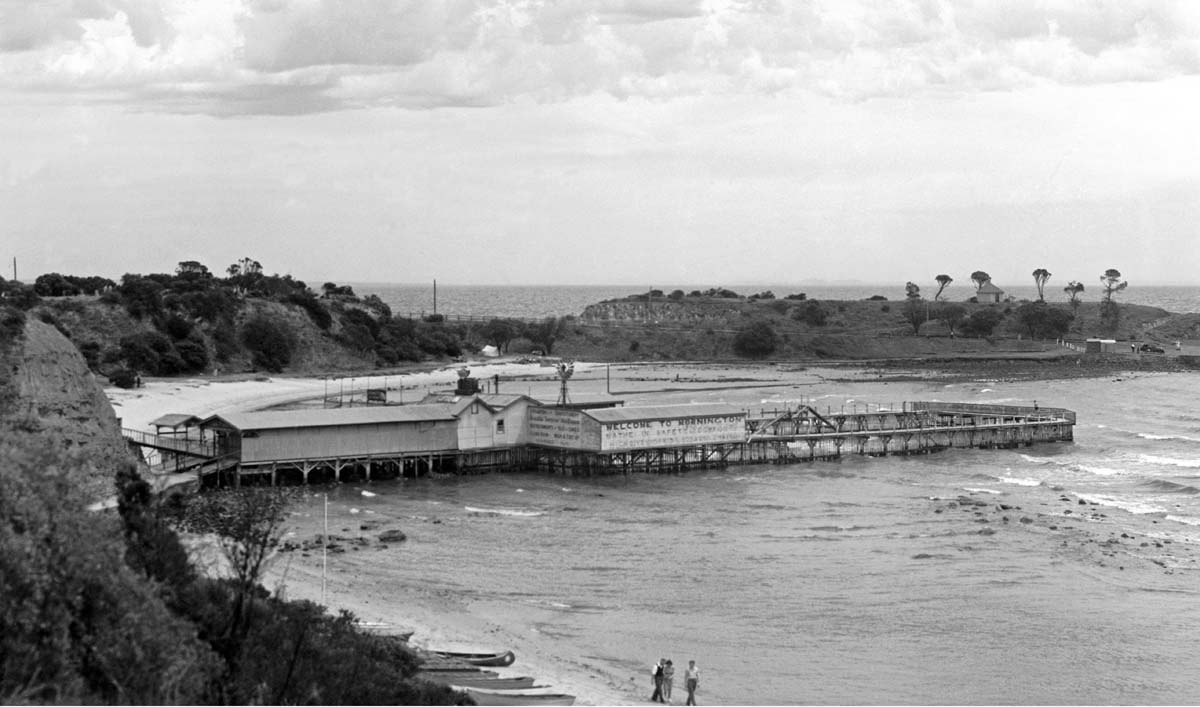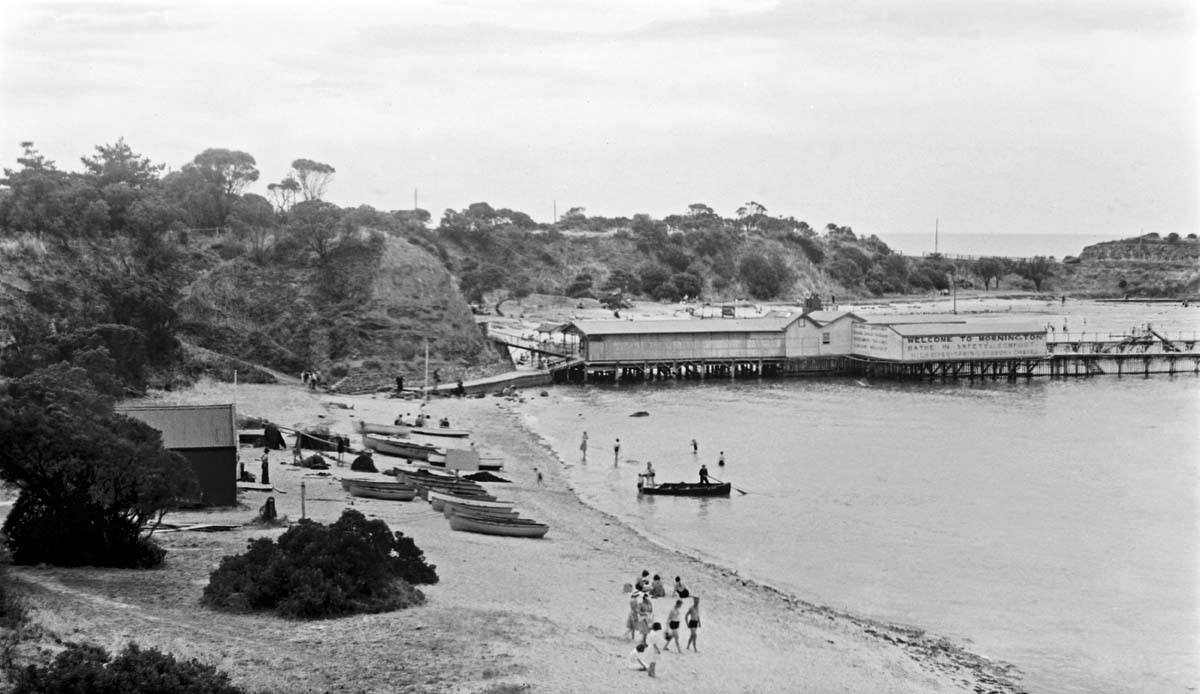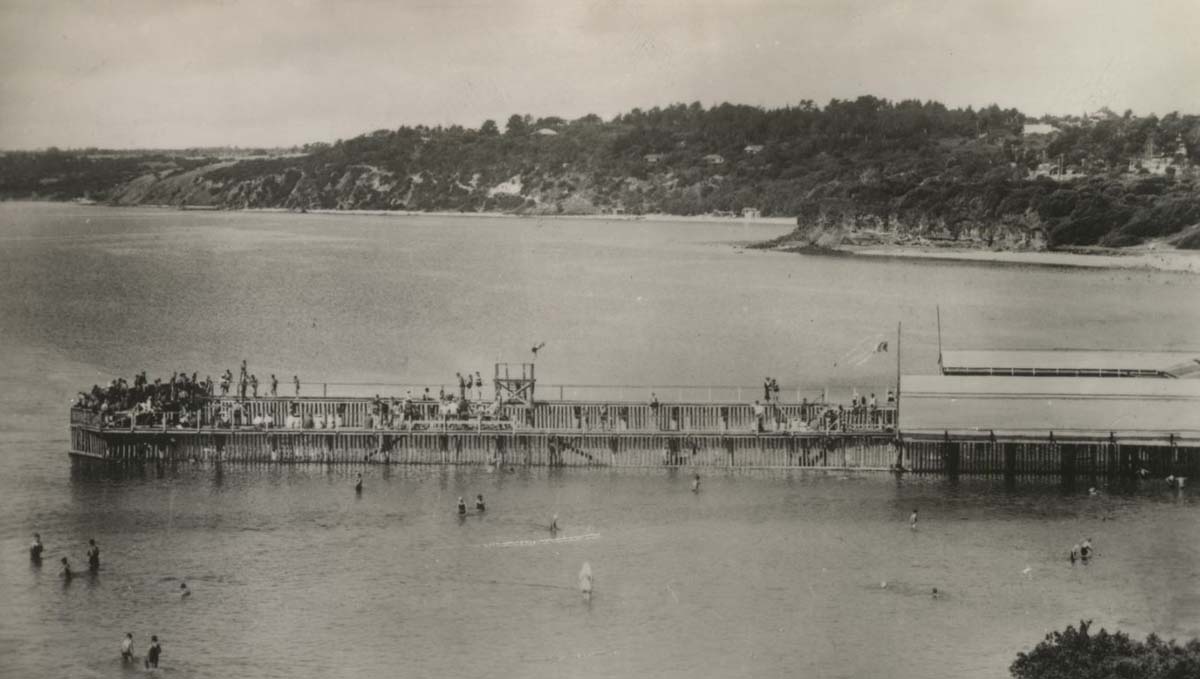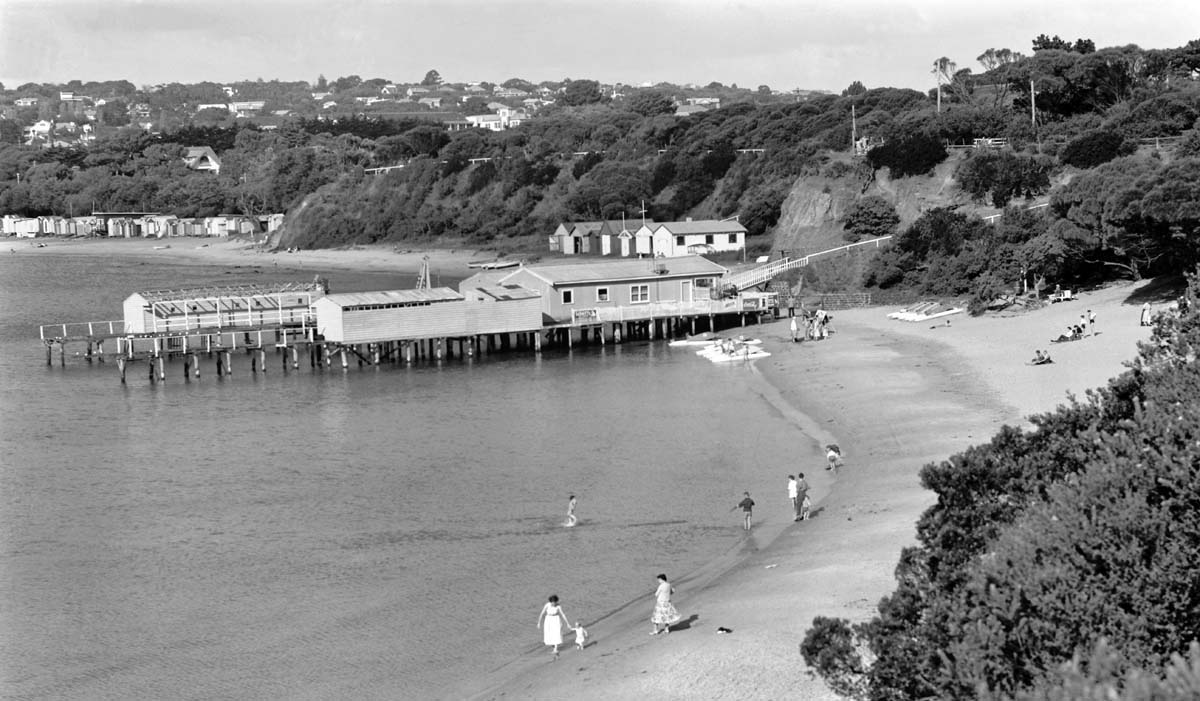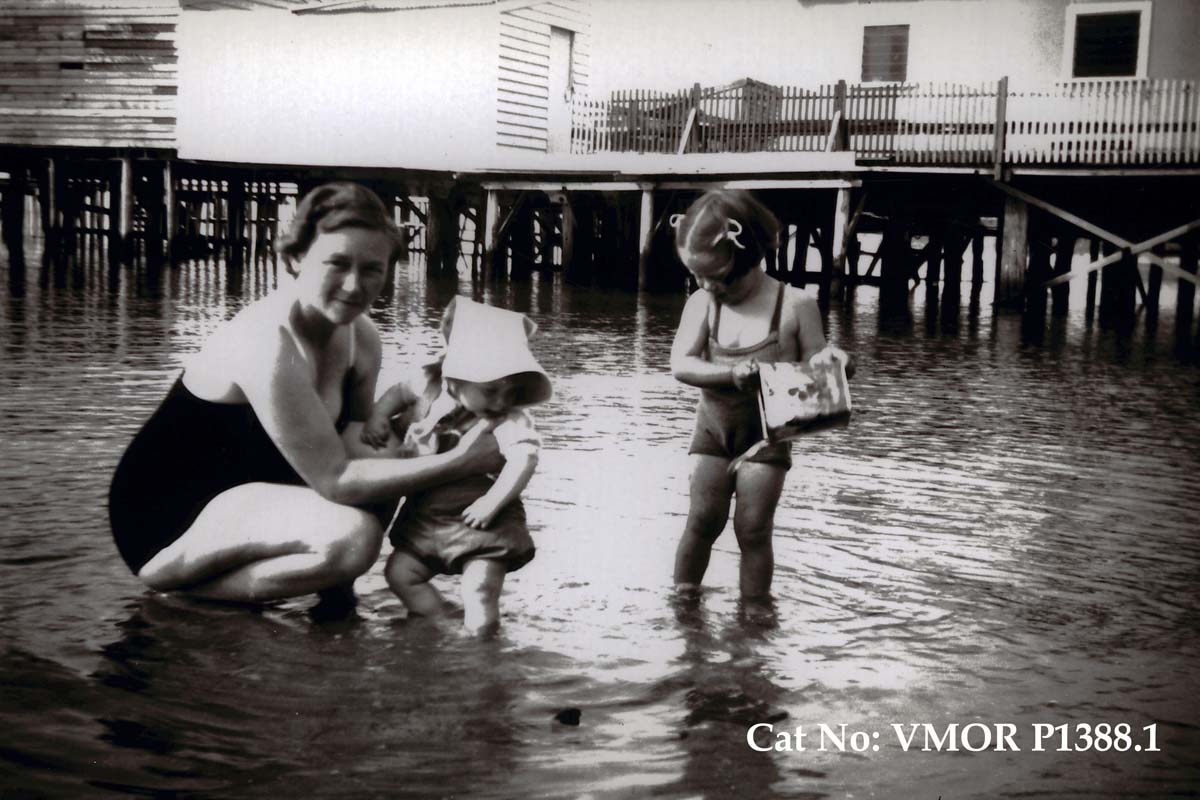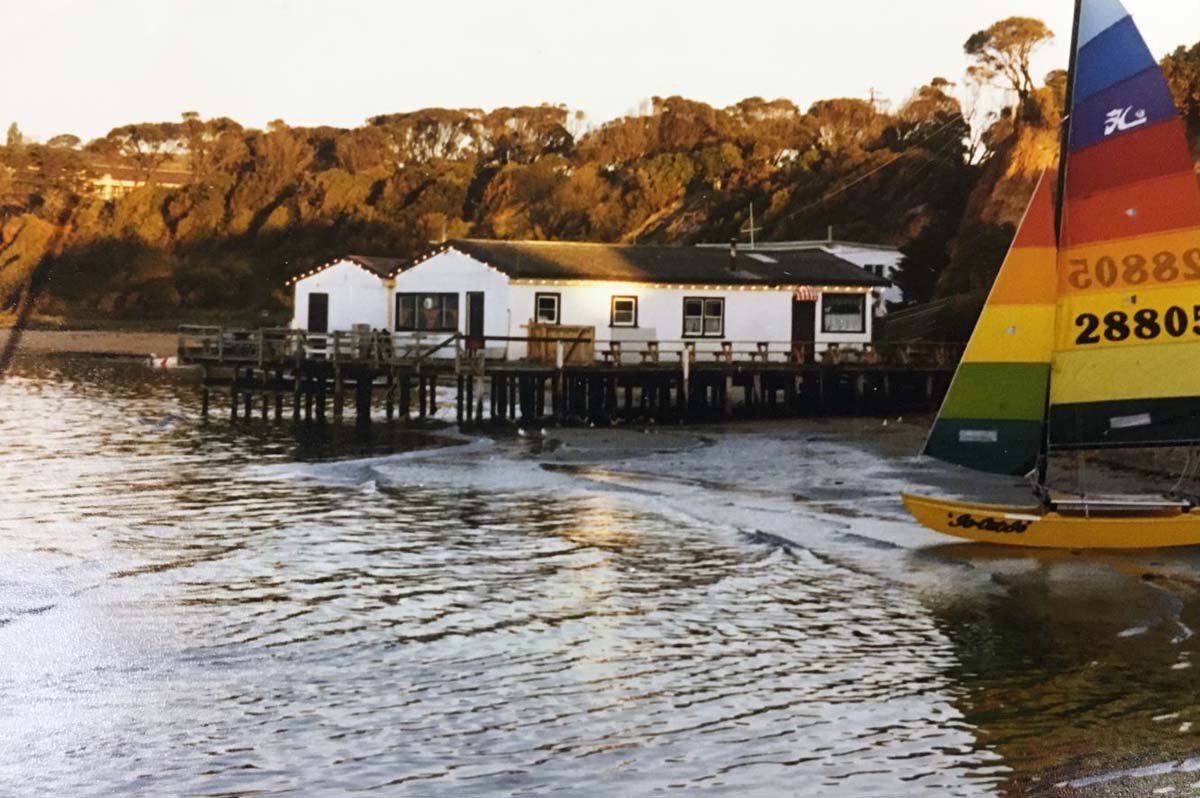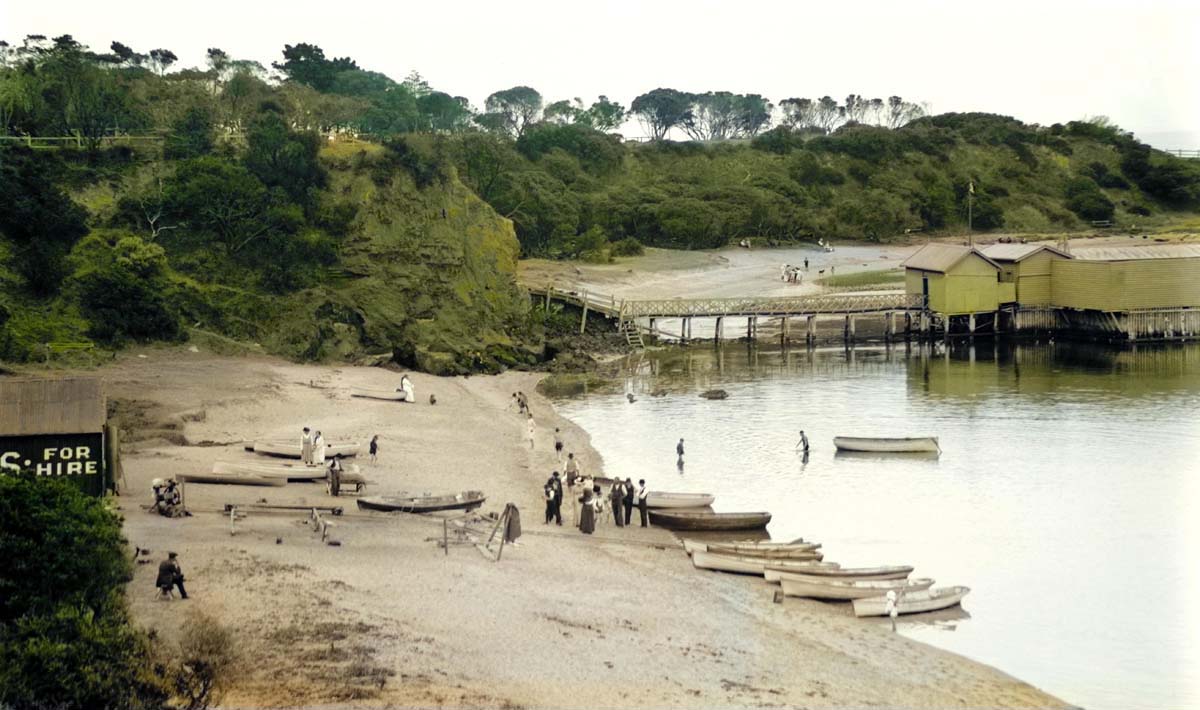
By Val Wilson (Mornington District Historical Society) and Peter McCullough
In June it was reported that Mornington Peninsula Shire councillor Susan Bissinger had floated the idea of sea baths as being the ideal solution to restore the eroded Portsea front beach (Mornington News. 15 June, 2021).The 2009 bay dredging has seen the once-fabled beach replaced by unsightly sandbags; a stop-gap measure to limit cliff erosion without any prospect of restoring the sand. It has proved to be an expensive eyesore as at least $8 million has been spent on the problem, including $2.5 million to replace the sandbag wall in 2019/2020.
The councillor’s proposal has not received unanimous support: “A sea bath/rock pool will not restore a sandy beach to Portsea, which is the outcome the community demands.” wrote Stuart Allen of Dromana in a letter to the editor (Mornington News. 22 June, 2021).
While Councillor Bissinger’s suggestion will no doubt play out in the coming months (perhaps years?), this would seem to be an opportune time to recall an era when sea baths were fashionable in Victoria, with particular reference to the Mornington Peninsula and Irvine’s Royal Baths in Mornington.
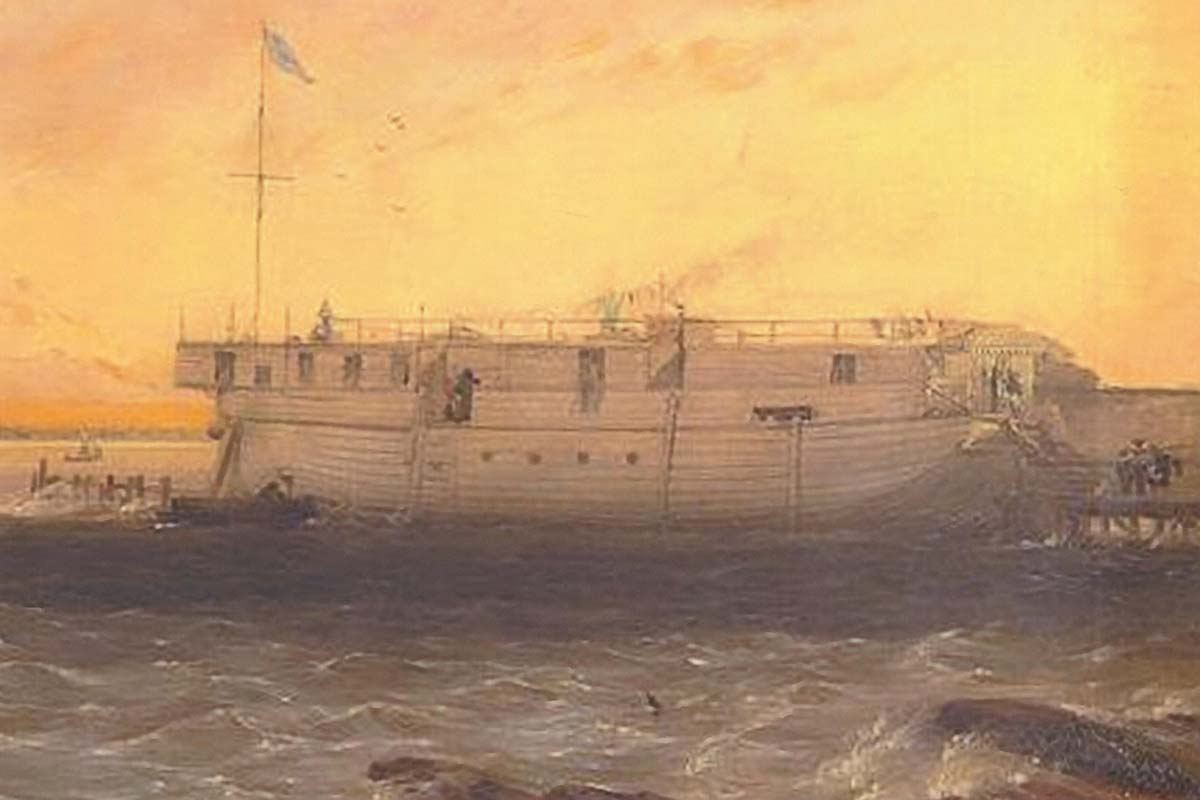
The First of the Baths
In the early years of settlement in Melbourne, public baths were a popular means of keeping clean. In the 1840’s there were several public baths along the Yarra River. The earliest of the sea baths in Victoria were a small bath house connected to the Pier Hotel in Sandridge (1842) and one at Corio (1844); they were small and roughly built with the latter even accommodating the occasional shark.
Then, on 10 December, 1859, an advertisement for Kenney’s Bathing Ship appeared in the Melbourne Argus. Captain William Kenney had purchased the condemned Scandinavian ship ‘Nancy’ in 1855 and beached her at St. Kilda. Bathers were taken out to the ship by dinghy and the following year he erected a fenced-in enclosure. This proved popular for those who enjoyed sea bathing, but were afraid to bathe in the open sea because of sharks. A slender walkway from the shore to the scuttled ‘Nancy’ was built in 1862. About the same time that the ‘Nancy’ was installed at St. Kilda, there appeared two other bathing ships: ‘The Premier’ at Sandridge and ‘The Protector’ at Williamstown.
With the ‘Nancy’ well established, Kenney then opened Kenney’s Ladies Baths a short distance away. Safety measures were often inadequate; in January 1907 a young lady drowned in just four feet of water with no one attempting to save her and the attendant unable to swim.
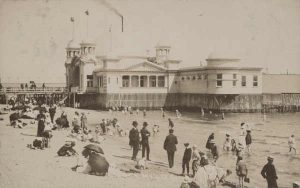
William Kenney managed to keep his Bathing Ship viable over the following years with continual maintenance necessary due to storms and gales. Siltation was another problem; in 1870 a man, having misjudged the depth, broke his neck diving at the baths. However, by 1909 the days of Kenney’s Sea Baths were numbered: the St. Kilda Foreshore Committee had other plans, the lease for the baths was not renewed, and by 1912 the old relic had disappeared.
Meanwhile, by the 1870’s sea baths had been established at Sandridge, Williamstown, Brighton, St. Kilda and Emerald Hill. During the next decade or so sea baths appeared in Sandringham, Mentone Mordialloc and Beaumaris and in fact, between 1842 and 1901, it is thought that as many as 50 sea baths were open to the public in Port Phillip. Throughout the nineteenth century there were as many as six different sea baths operating along the St. Kilda shoreline. The most prominent of these, with its cluster of domes, would not have looked out of place at English resorts such as Blackpool or Brighton. In 1907 the Department of Health reviewed the 17 sea baths still operating in the metropolitan area. Further afield, sea baths were plentiful around Geelong and could be found at Queenscliff, Portarlington and Clifton Springs, Lorne, Portland, Warrnambool and Port Fairy, San Remo and Cowes.

Sea Baths On The Mornington Peninsula
SORRENTO: The Sorrento sea baths were the earliest along the Peninsula, being built in 1875 by the town’s entrepreneur developer, George Coppin. As these were the only baths in operation it was necessary for ladies and gentlemen to bathe at different times of the day; for the ladies it was a white flag and for men the red flag. Pranksters sometimes removed a few pickets and on one occasion a small shark entered the enclosure creating a degree of panic. These baths lasted until the 1970’s when they were wrecked in a storm.
G.B.Kerford built a jetty and bathing enclosure in front of his Sorrento residence before 1890. On a scale comparable to most public baths at the time, they were the first to be built in Victoria purely as private baths. Subsequently, in the first decade or so of the twentieth century, about 25 private jetties were built between the Sorrento and Portsea piers. Most of these originally included small baths at their deep end but as storm damage repairs have been carried out over the years the baths have been removed in most cases.
FRANKSTON: In December 1883 Mark Young, the owner of the Pier Hotel, placed an advertisement to the effect that his hotel now had “enclosed sea baths.” Located approximately one hundred metres off the coastline of Frankston beach and constructed at a cost of 950 pounds, they were connected to the hotel by a suspension bridge over Kananook Creek.
By 1888 Young had sold the baths to Frankston Shire Council but a succession of lessees had difficulty in maintaining them. Then in November 1898 a fierce storm did considerable damage with debris from the baths being strewn along the coastline. No further effort was made to undertake repairs or reopen the baths to the public.
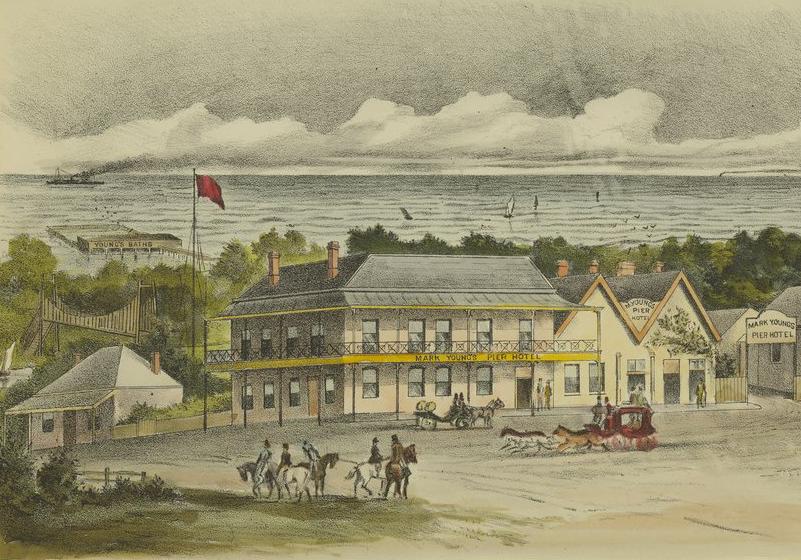
MORNINGTON: In 1878 the proprietor of the Royal Hotel erected splendid sea baths at The Point. Two years later they were available to let and in due course William Irvine became the proprietor, also offering rowing and sailing boats for hire. Early in 1892 it was stated in “The Mornington Standard” that the Royal Sea Baths were to be found in “a secluded position within easy distance of the township” and a hot sea bath was also available. As indicated in the Mornington Standard of 2 November 1899, there were separate bathing times for men and women.
While the bathing times were strictly enforced, some shire councilors were at odds with the bathing costume requirements of the day, or rather the lack of such requirements. Cr. Cornford, in the years 1902 and 1905, proposed unsuccessfully that a bylaw be adopted enforcing the compulsory wearing of bathing costumes by men at the Mornington baths. This motion was consistently rejected and opposed on the grounds that it would be an infringement of the liberty and rights of the people using the baths. It would also harm tourism as the wearing of bathing costumes was not compulsory at any other baths around the bay. Cr. Cornford was supported in his motion by Cr. Stephens; it was shameful, he said, to observe bathers running along the springboard! Whether or not they were Mornington residents he would not say. The opposing view was that it was generally accepted that sea bathing, with the salt penetrating the pores of the skin, was beneficial to good health; the more skin exposed the better! However the motion in favour of compulsory costumes was finally passed in December, 1905. Much earlier, at Sandridge in 1868, two men were sent to gaol for indecent exposure after undressing for a swim.
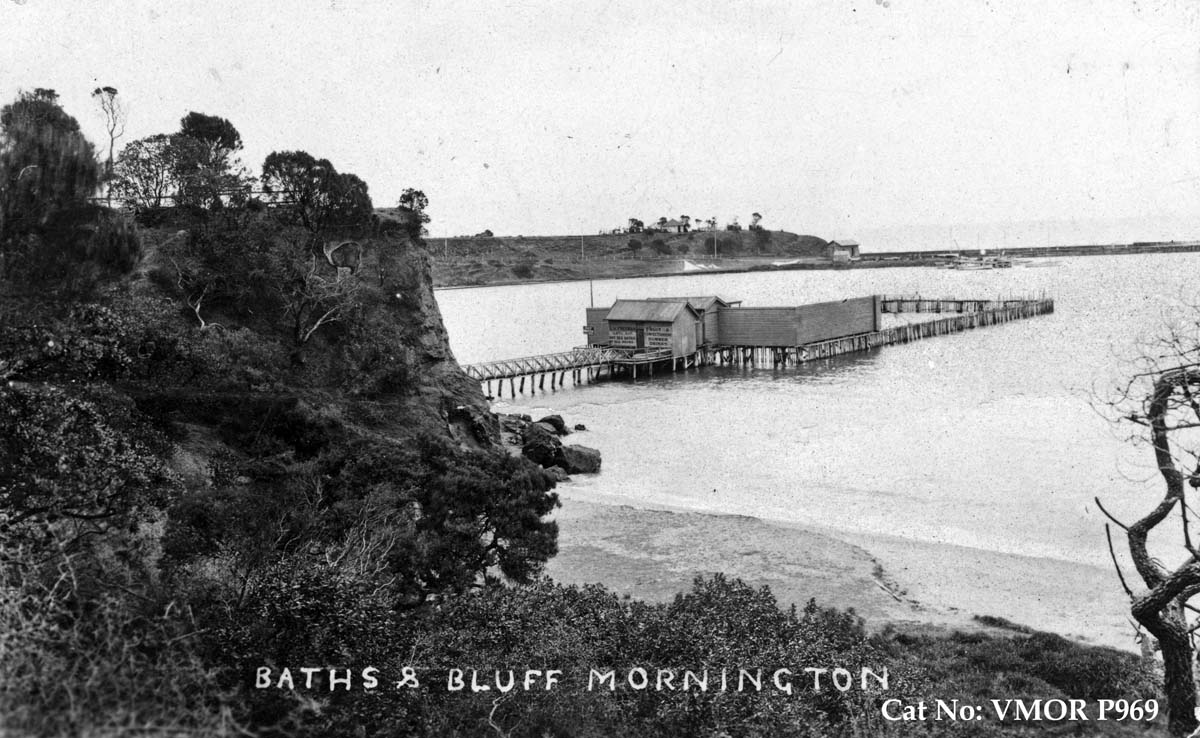
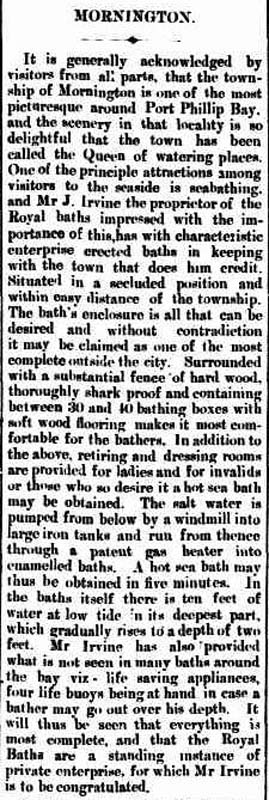
Eventually the weight of public opinion prevailed; in January 1917 restrictions on mixed bathing were lifted and men and women could bathe together without it being an offence. Sunday bathing was legalized in 1922. However strict codes on the wearing of bathers were enforced by councils; after all the years romping around naked, it was not until 1938 that men were officially allowed to bare their chests on Victorian beaches. As mixed bathing became increasingly accepted the sea baths were less patronized and their era started to draw to a close. None-the-less a certain number remained loyal as the sea baths provided diving platforms and, for the timorous, known depths of water and security from sharks. In 1930 there was an horrific shark attack on a young man at Middle Brighton. Despite his frantic struggles he was dragged out to sea in front of about 100 horrified onlookers. For a while after this event attendances inside sea baths soared.
Following the death of William Irvine in 1901 the Royal Sea Baths were run for a time by his wife Margaret. In November, 1915 the Mornington Swimming and Lifesaving Club held its inaugural meeting at the baths which then became its base. During the early years of the twentieth century additions were made to the original building, extending towards the shore to create a dance hall.
In 1947 the Mornington sea baths were severely damaged by fire. A small restaurant/kiosk and boat hire business operated from the location for some time but the remains of the structure were eventually demolished in in 1981.
PORTSEA: The recent proposal by Cr. Bissinger that Portsea should opt for a sea baths brings to mind the old adage that there is nothing new under the sun. Although details are somewhat sketchy, Bruce Bennett in his comprehensive survey of the sea baths phenomenon (“Sea Baths of Victoria”) points out that James Sandle Ford, builder of the Nepean Hotel, is credited with having built the Portsea Baths between the pier and Point Franklin. Its existence was mentioned in The Argus of March, 1875; the same year that the hotel was built. Bennett suggests that this may have been the private bathing place of John Cain, a son-in-law of Ford and subsequent owner of the hotel.
Be this as it may, John Hanlon Knipe also procured a site for swimming baths about 20 metres from the jetty and “Leading inhabitants of Portsea subscribed the cost of erecting a vast baths enclosure with the usual conveniences upon a beautiful shelving sandy beach…” (Bennett. Page 100). By December, 1877 Portsea had a rotunda and new baths available.
Bennett’s account concludes: “Part of the Portsea Baths was swept away in June, 1878…W.B.Ford, the manager of the Portsea Hotel, advertised the use of the Portsea Baths free to guests in December, 1880, but did not mention them the next year or thereafter. Their exposed location and their construction on the beach rather than on piles probably made them vulnerable to storm and tide.”(Ibid)
Although the text is a little vague, it would appear that Portsea made two attempts to be part of the sea baths era and both were rather short-lived.
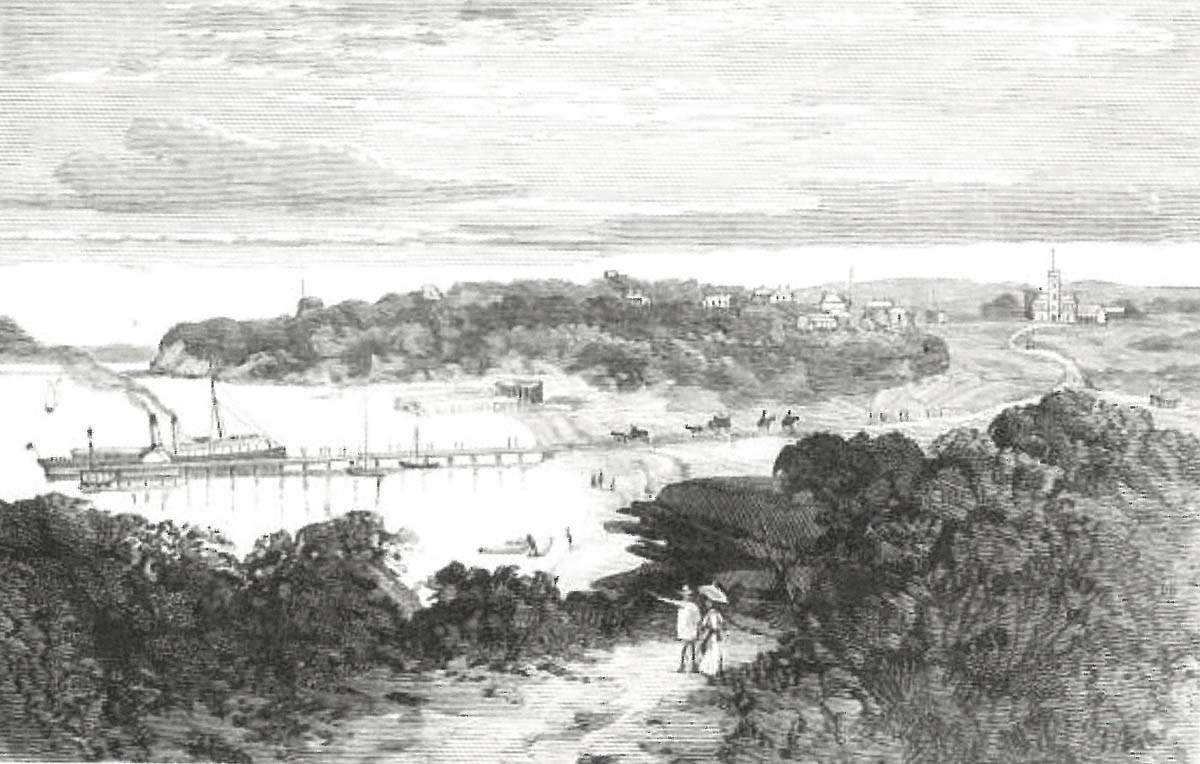
HASTINGS: As the nineteenth century drew to a close the citizens of Hastings could only boast a ladies bathing box built in the mud flats in the 1890’s although the punt ‘Maggie’, removed in 1889, had provided local youngsters with a bathing ship for some years. Then in 1896 council considered a sea baths proposal but were put off by the recent Frankston experience and a lack of funds.
Not wishing to be left behind, a public meeting was called in 1909 and it was enthusiastically resolved to build baths on the Hastings foreshore. However the mills of the gods grind a little more slowly on the Western Port side of the Peninsula: it was 19 November, 1938 before the salt water pool was opened. A three metre diving well was added in 1939.
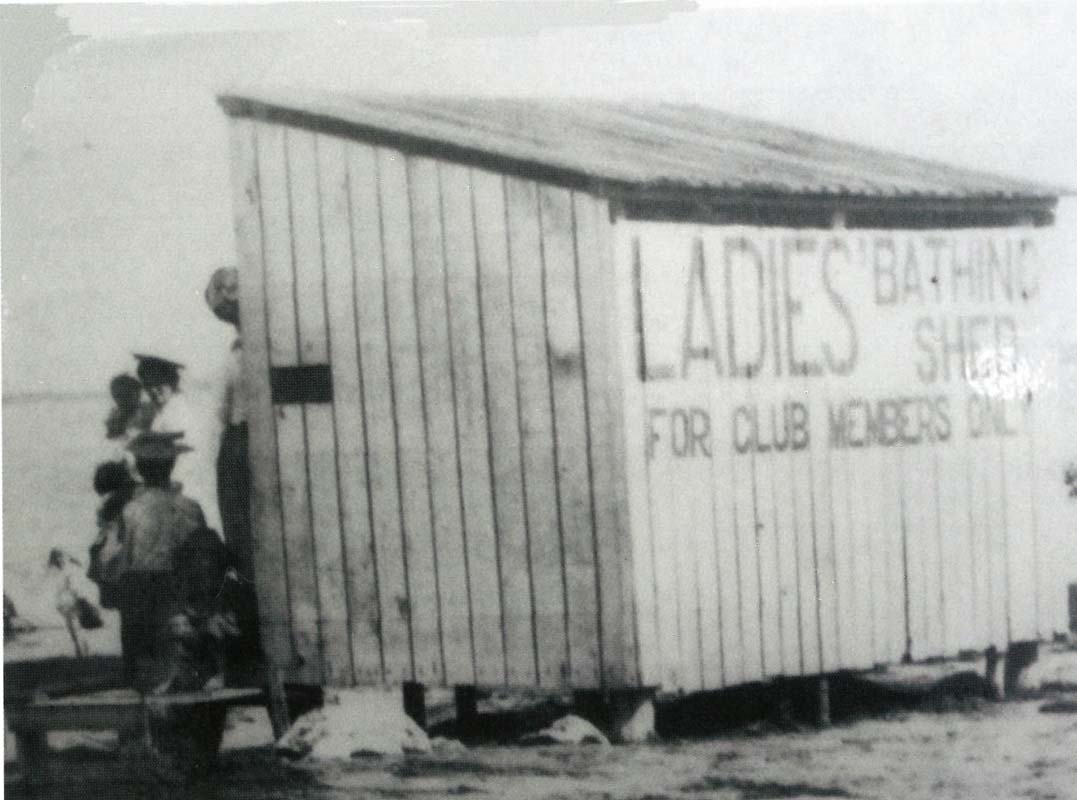
One old identity recalled: “The pool was filled by a pipe which went out to the ‘low water mark’ under the original old wooden pier. Small sharks, cowfish, puffer fish, toadies – all sorts of fish – would at times be found in the pool, entering through the pipe.” (Hastings People & Places, Volume 2, Page 53). This uninvited company notwithstanding, the pool was a great place for young people to socialize and used extensively for school swimming sports after the inaugural swimming competition between Mordialloc and Frankston High Schools which was held in March, 1940.
The problems of fish and water discolouration were solved when the pool was converted to fresh water in the 1960’s. It was closed in 2003 to make way for the Pelican Park Recreation Centre, complete with 25 metre indoor pool and restaurant.
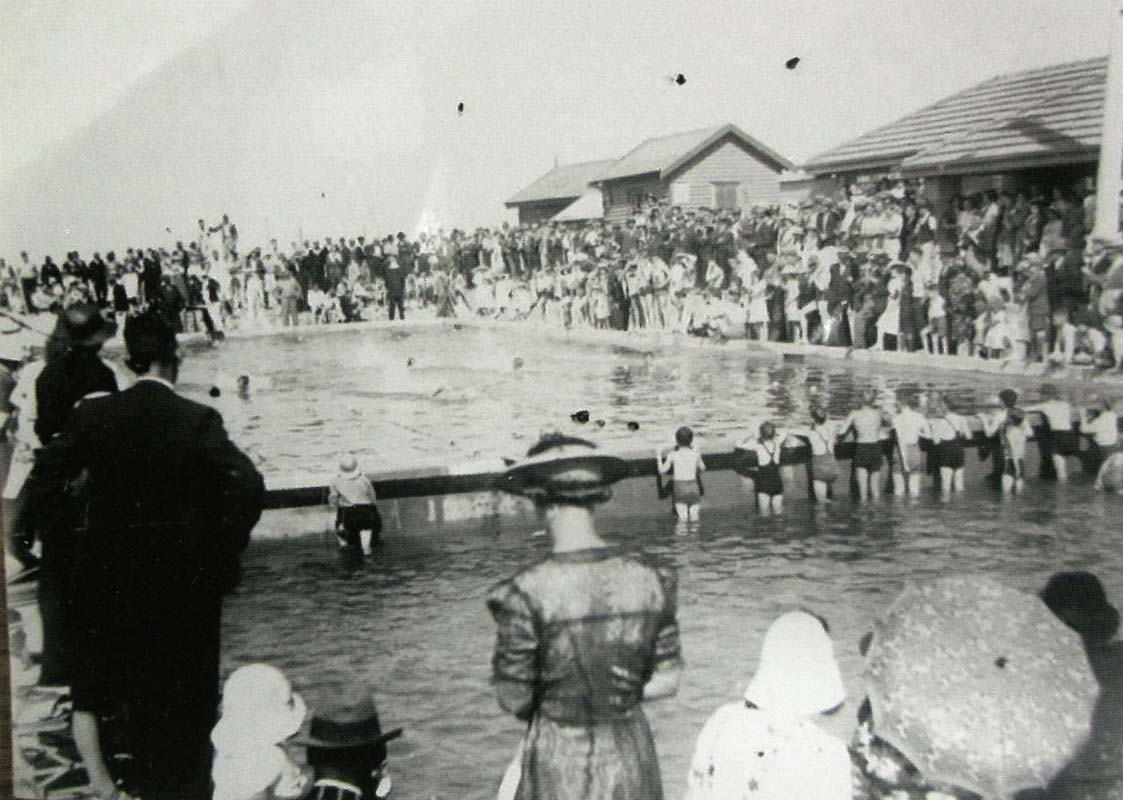
What Remains?
Attendance at sea baths everywhere experienced a gradual decline; this can be blamed on the move to open water bathing as well as the rise in numbers of land-based fresh water swimming pools and even backyard pools. Moreover, the number of pools declined as the weather took its toll. A massive storm in 1934 demolished a number of these ageing structures and severely damaged others. Bruce Bennett provides a number of graphic accounts of the havoc created. For instance, at Middle Park “…the caretaker J. Lamb’s house shook from the violence of it. One wing of the sea end of the baths was demolished, the dressing rooms crumpled one by one and loose planks rammed against the building causing much damage. Waves broke through the flooring and the whole of the wall of the baths were blown away.” (Ibid. Page 52.) Fire also destroyed or damaged a number of these old wooden structures.
Today, while sea baths are plentiful in New South Wales, the only places in Victoria where you can still experience the delight of large sea baths are at Geelong and Middle Brighton. Is it possible that this short list will be extended in the future to include Portsea?

William Miller Irvine
William Irvine was a Scot who arrived in New South Wales with his wife Margaret in 1853.Soon after they came to Victoria where they tried their luck at the diggings at Daylesford and Castlemaine before spending a short time in New Zealand.
After returning to Victoria, William Irvine took care of the grounds at Beleura for 16 years when the property was owned by Charles Bright, founder of Bright Brothers & Co. Steamship and General Agents. During this time he bought land in the township. William Irvine was the librarian of the local library which was housed in the Mechanics Institute of which he was the secretary. He and his wife worked tirelessly to raise money for the Mechanics Institute building fund. Opened in 1885, it has been used as council offices since 1940.Irvine’s main claim to fame, however, was his management of what was known as Irvine’s Royal Sea Baths.
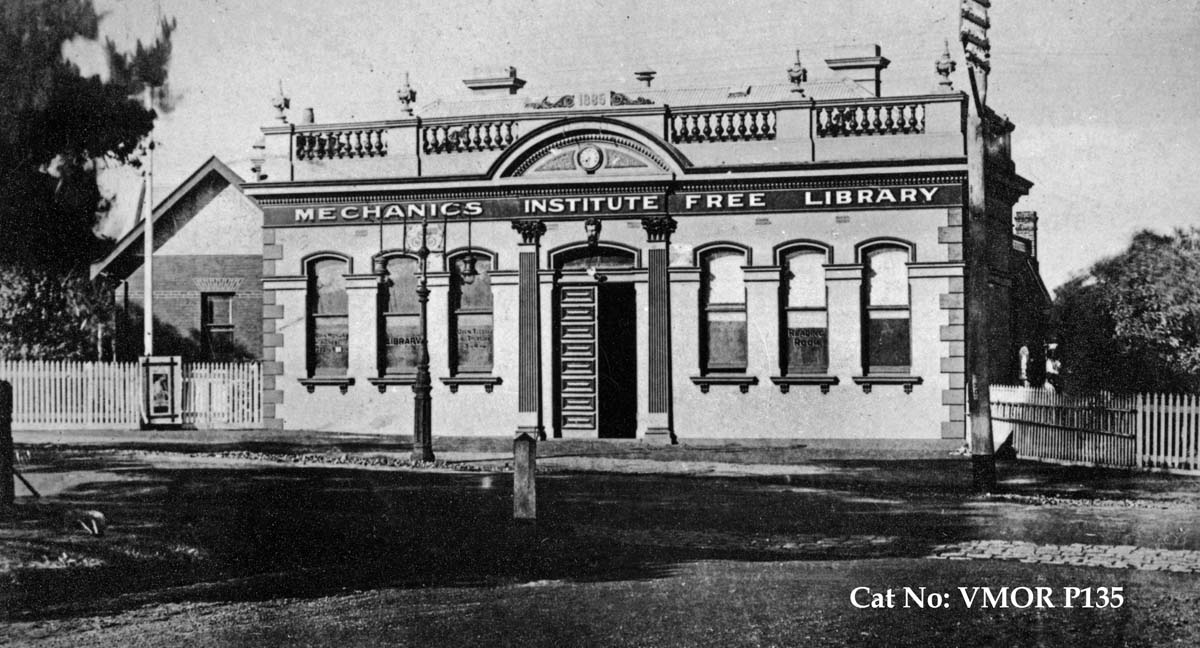
William Irvine was a councilor of the Mornington Shire and, as a Justice of the Peace, he served on the bench of the Mornington Court. He died on 15 July, 1901 at the age of 74 and is buried in the Mornington cemetery. Margaret, who took over the management of the baths after the death of her husband, died in 1911 and is also buried at Mornington.
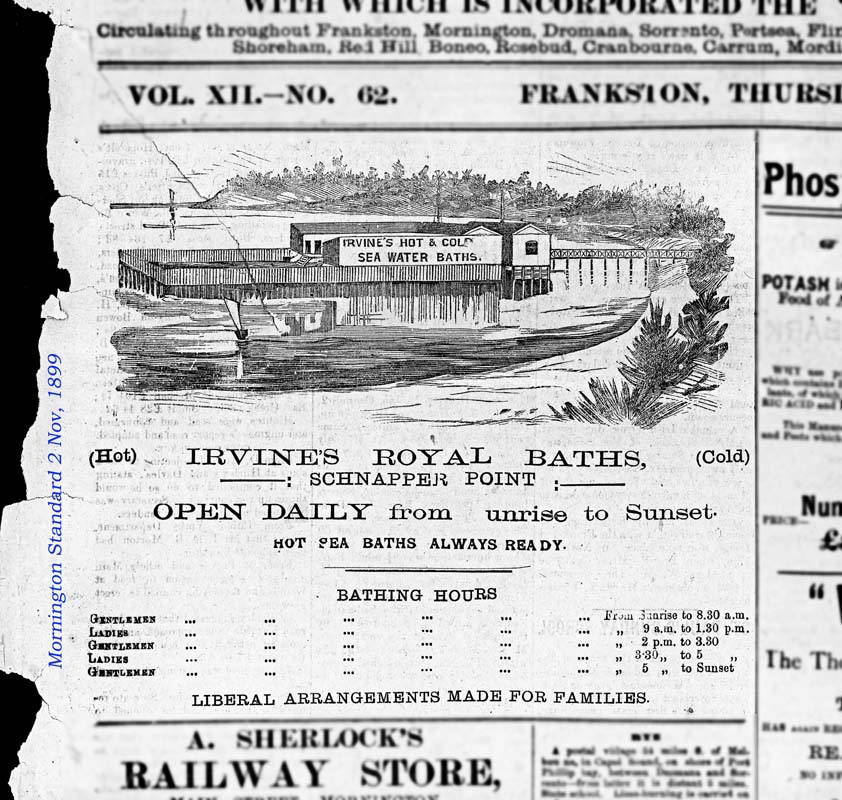
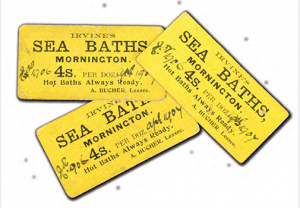
REFERENCES
- Bennett, Bruce. “Sea Baths of Victoria.” 2013
- “Hastings People and Places” Volume 2. Hastings and Western Port Historical Society.
- Latimer, Val. Article “When Frankston Had a Sea Baths (1883-1898)”Peninsula Essence, October 2019

